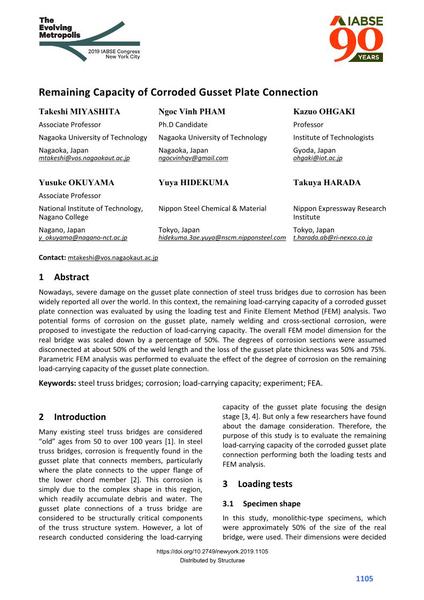Remaining Capacity of Corroded Gusset Plate Connection

|
|
|||||||||||
Bibliografische Angaben
| Autor(en): |
Takeshi Miyashita
(Nagaoka University of Technology )
Ngoc Vinh Pham (Nagaoka University of Technology) Kazuo Ohgaki (Institute of Technologists) Yusuke Okuyama (National Institute of Technology, Nagano College) Yuya Hidekuma (Nippon Steel Chemical & Material) Takuya Harada (Nippon Expressway Research Institute) |
||||
|---|---|---|---|---|---|
| Medium: | Tagungsbeitrag | ||||
| Sprache(n): | Englisch | ||||
| Tagung: | IABSE Congress: The Evolving Metropolis, New York, NY, USA, 4-6 September 2019 | ||||
| Veröffentlicht in: | The Evolving Metropolis | ||||
|
|||||
| Seite(n): | 1105-1110 | ||||
| Anzahl der Seiten (im PDF): | 6 | ||||
| DOI: | 10.2749/newyork.2019.1105 | ||||
| Abstrakt: |
Nowadays, severe damage on the gusset plate connection of steel truss bridges due to corrosion has been widely reported all over the world. In this context, the remaining load-carrying capacity of a corroded gusset plate connection was evaluated by using the loading test and Finite Element Method (FEM) analysis. Two potential forms of corrosion on the gusset plate, namely welding and cross-sectional corrosion, were proposed to investigate the reduction of load-carrying capacity. The overall FEM model dimension for the real bridge was scaled down by a percentage of 50%. The degrees of corrosion sections were assumed disconnected at about 50% of the weld length and the loss of the gusset plate thickness was 50% and 75%. Parametric FEM analysis was performed to evaluate the effect of the degree of corrosion on the remaining load-carrying capacity of the gusset plate connection. |
||||
| Stichwörter: |
Korrosion
|
||||
